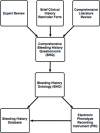Creating an ontology-based human phenotyping system: The Rockefeller University bleeding history experience
- PMID: 20443924
- PMCID: PMC5350758
- DOI: 10.1111/j.1752-8062.2009.00147.x
Creating an ontology-based human phenotyping system: The Rockefeller University bleeding history experience
Abstract
The lack of standardized methods for human phenotyping is a major obstacle in translational science. We have developed a bleeding history phenotyping system comprising an ontology, a questionnaire, a Web-based phenotype recording instrument (PRI), and a database. The ontology facilitates transparency, collaboration, aggregation of data, and data analysis. The integrated system allows investigators worldwide to use the PRI, add their de-identified data to the database, and query the aggregated data. Thus, this system can increase the power to detect genotype-phenotype-environment relationships and help new investigators begin their studies. We anticipate that this approach may be applicable to other disorders.
Figures



References
-
- Shindler E. Framingham heart study. Available at: http://www.framinghamheartstudy.org/about/milestones.html. Accessed September 14, 2009.
-
- Freimer N, Sabatti C. The human phenome project. Nat Genet. 2003; 34(1): 15–21. - PubMed
-
- Ashburner M, Ball CA, Blake JA, Botstein D, Butler H, Cherry JM, Davis AP, Dolinski K, Dwight SS, Eppig JT, Harris MA, Hill DP, Issel‐Tarver L, Kasarskis A, Lewis S, Matese JC, Richardson JE, Ringwald M, Rubin GM, Sherlock G. Gene ontology: tool for the unification of biology. The Gene Ontology Consortium. Nat Genet. 2000; 25(1): 25–29. - PMC - PubMed
-
- Coller BS, Schneiderman PI. Clinical evaluation of hemorrhagic disorders: The bleeding history and differential diagnosis of purpura In: Hoffman R, Benz EJ, Shattil SJ, Furie B, Silberstein LE, McGlave P, eds. Hematology: Basic Principles and Practice. New York : Churchill Livingstone, 2009, 1851–1876.
Publication types
MeSH terms
Grants and funding
LinkOut - more resources
Full Text Sources
Medical

